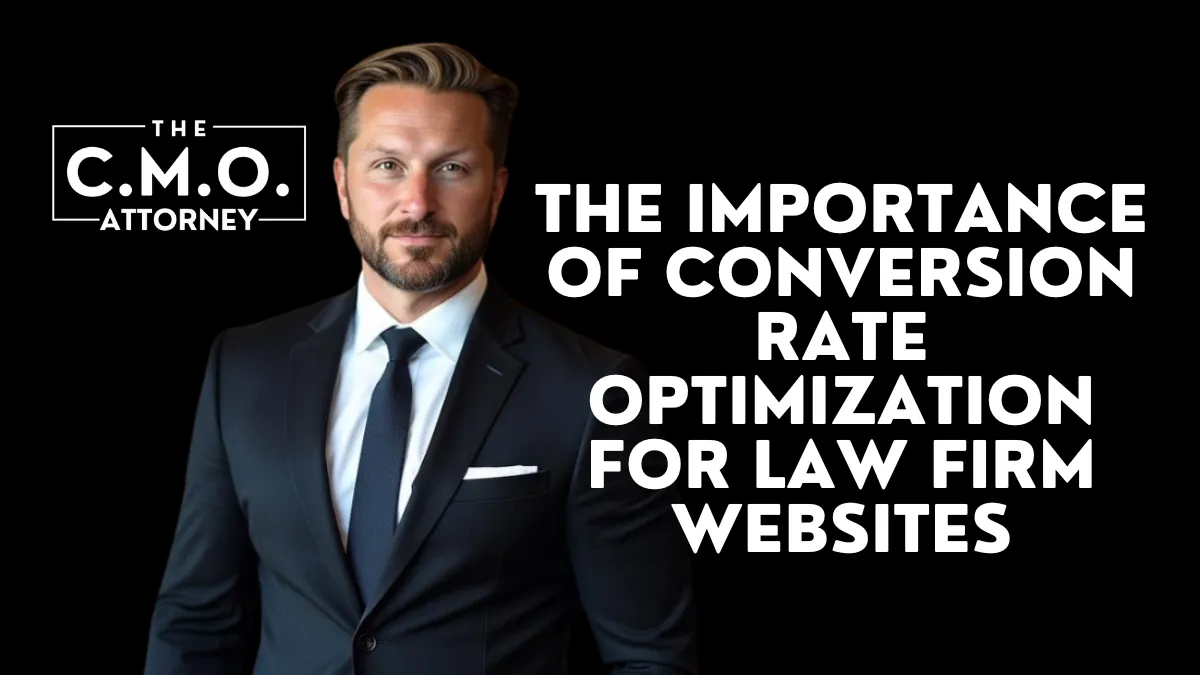 The Importance of Conversion Rate Optimization for Law Firm Websites
The Importance of Conversion Rate Optimization for Law Firm Websites
Every interaction counts and conversion rate optimization for law firm websites is crucial for turning website visitors into actual clients. With an increasing number of legal consumers searching for services online, law firms must optimize their websites to ensure they are not only attracting visitors but converting them into meaningful leads. Effective conversion rate optimization for law firm websites increases the return on investment (ROI) for marketing efforts and maximizes client acquisition.
The CMO Attorney covers the vital aspects of conversion rate optimization for law firm websites, offering strategies to enhance user experience, improve design, and convert visitors into clients. Whether you are just getting started or want to refine your existing website strategy, these insights can help take your law firm’s online presence to the next level.
What Is Conversion Rate Optimization for Law Firm Websites?
Conversion rate optimization (CRO) refers to the practice of improving a website to increase the percentage of visitors who take a desired action. For law firms, this typically means optimizing the website so that more visitors schedule consultations, complete contact forms, or call the firm. The goal is to make it as easy as possible for potential clients to reach out and inquire about legal services. This involves analyzing user behavior and tweaking website elements such as CTAs, forms, and page design to boost conversion rates.
Why CRO Matters for Law Firms
The legal market is more competitive than ever, and without focusing on conversion rate optimization for law firm websites, your firm could be losing valuable business. A website may attract traffic, but if visitors don’t convert into clients, your firm is missing out on critical opportunities. CRO helps ensure that your marketing budget is spent efficiently by transforming web traffic into tangible, high-quality leads. By enhancing conversion rates, law firms can maximize their online investments and increase their chances of acquiring new clients.
Key Elements of Conversion Rate Optimization for Law Firm Websites
Several key elements are crucial in optimizing a law firm website to increase its conversion rate. From site design to call-to-action strategies, these components work together to create a streamlined, user-friendly experience that ultimately drives conversions.
1. User-Friendly Design and Navigation
A user-friendly design is one of the most important factors in conversion rate optimization for law firm websites. Visitors should be able to navigate your site with ease, finding the information they need in just a few clicks. A confusing layout or difficult navigation can drive potential clients away before they even take action. Ensure that your website has a clean, modern design with clearly labeled menus, easy-to-find contact details, and well-organized content to enhance the user experience.
2. Optimized Landing Pages
Landing pages are critical touchpoints on your website where visitors can take the desired action—whether it’s filling out a contact form, signing up for a consultation, or calling your office. Optimized landing pages focus on delivering relevant, concise messaging, fast loading times, and easy-to-find calls-to-action. Make sure your landing pages align with your visitors’ needs and provide them with the information they are looking for without distraction.
3. Effective Call-to-Actions (CTAs)
A call-to-action (CTA) is one of the most powerful tools in conversion rate optimization for law firm websites. Your CTAs should be highly visible, persuasive, and action-oriented. Whether it’s “Get Your Free Consultation Today” or “Speak with an Experienced Attorney Now,” your CTA should clearly tell visitors what to do next. Strong CTAs drive engagement and are essential for turning website visitors into leads.
4. Mobile Optimization
With more users browsing websites on their mobile devices, ensuring your law firm website is mobile-optimized is no longer optional—it’s necessary. If your website isn’t mobile-friendly, potential clients may leave in frustration, reducing your chances of conversion. Ensure that your website functions seamlessly on all devices, providing an equally compelling experience for mobile users as it does for desktop users.
5. Trust Signals and Testimonials
Trust signals play a crucial role in conversion rate optimization for law firm websites. Visitors want to feel confident in their choice of legal representation. Displaying client testimonials, case results, accreditations, and awards helps establish credibility and trust. Testimonial quotes from past clients provide social proof, while accolades and legal certifications validate your firm’s expertise. These trust elements reassure potential clients that they are in capable hands.
6. A/B Testing
To continually optimize your website, consider using A/B testing. This process involves testing different versions of website elements—such as headlines, CTAs, or images—to determine which variation performs best. By using data-driven insights to tweak elements on your site, law firms can make informed decisions and achieve higher conversion rates. Regular A/B testing ensures that your website is always evolving and improving.
7. Fast Website Loading Speed
A slow website is one of the quickest ways to lose potential clients. If your website doesn’t load quickly, visitors will likely bounce before engaging with any content. Even a small delay can result in significant drops in conversion rates. Optimize your website’s performance by compressing images, minimizing scripts, and using a content delivery network (CDN) to ensure fast page load times.
8. Clear Value Proposition
A clear value proposition explains why visitors should choose your law firm over competitors. This message should be visible immediately upon landing on your site. Whether you specialize in a specific practice area, offer unmatched experience, or focus on personalized service, make sure your value proposition is compelling and tailored to your ideal clients’ needs.
9. Strong, Persuasive Content
Content is a key driver of conversions. Well-written, persuasive copy that speaks to your potential clients’ pain points can turn visitors into leads. Conversion rate optimization for law firm websites requires that content be informative, engaging, and focused on addressing visitors’ legal challenges. Use case studies, FAQs, and blog posts to showcase your expertise and demonstrate how you can provide solutions for your clients’ legal issues.
10. Clear Contact Information
Finally, ensure that contact information is easy to find and prominently displayed on your website. Whether it’s a phone number, email, or a contact form, make sure your visitors know how to reach you with ease. Including live chat options can further increase engagement and provide immediate assistance, which can help boost conversions.
Leveraging Social Proof to Boost Conversions on Law Firm Websites
Social proof is a psychological trigger that can be highly effective in influencing website visitors. People often look to the experiences of others to help make decisions, especially when considering legal services. Leveraging social proof—such as client testimonials, case studies, endorsements, and online reviews—on your website can help boost trust and conversions. By showcasing real client experiences and outcomes, your firm can position itself as trustworthy and credible.
Client reviews, detailed case studies, and endorsements from reputable organizations increase credibility and help establish your law firm as an authority in the field. Social media engagement also plays a crucial role in building trust, so make sure to link your firm’s social media profiles on your website, allowing potential clients to see positive interactions and feedback.
The Role of Data and Analytics in CRO for Law Firms
To refine your website’s conversion rate optimization for law firm websites, using analytics tools like Google Analytics is essential. These tools provide valuable data on how users are interacting with your site, which pages they visit most, where they drop off, and what actions they take. By regularly analyzing this data, you can identify which aspects of your site are performing well and which need improvement. Data-driven decisions allow you to continually optimize your site and improve conversion rates over time.
Incorporating conversion rate optimization for law firm websites is vital to transforming website visitors into clients. Whether through optimized landing pages, mobile-friendly design, persuasive content, or social proof, each element plays a crucial role in increasing conversions. At The CMO Attorney, we specialize in helping law firms optimize their websites to drive better results and convert more leads. If you are ready to elevate your law firm’s website performance, sign up for a free consultation today!
Sources:
-
Neil Patel – Conversion Rate Optimization
Neil Patel is a leading authority in digital marketing, offering insights into conversion rate optimization and actionable strategies for improving website performance.
Neil Patel’s Guide to Conversion Rate Optimization -
HubSpot – How to Optimize Your Website for Conversion
HubSpot provides a comprehensive guide on how to optimize websites for higher conversions, using best practices and industry data.
HubSpot Conversion Optimization Guide -
Moz – Conversion Rate Optimization Best Practices
Moz is a trusted resource in SEO and digital marketing, offering best practices and insights to improve conversion rates on law firm websites.
Moz Conversion Rate Optimization
